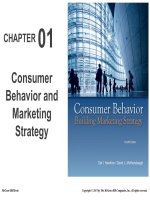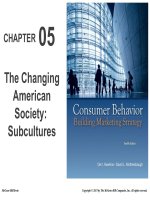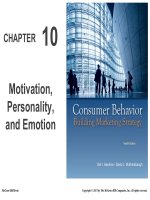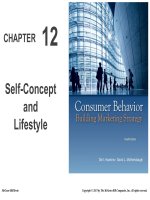74 test bank for consumer behavior building marketing strategy 11th edition
Bạn đang xem bản rút gọn của tài liệu. Xem và tải ngay bản đầy đủ của tài liệu tại đây (101.78 KB, 23 trang )
74 Test Bank for Consumer Behavior Building Marketing
Strategy 11th Edition
by Hawkins Multiple Choice Questions - Page 1
It is critical that a firm consider value from which perspective?
1.
A. the competition's
2.
B. the firm's
3.
C. the customer's
4.
D. the government's
5.
E. the industry's
The segment(s) within the larger market on which an organization
will focus its marketing effort is referred to as the _____.
1.
A. need set
2.
B. target market
3.
C. customer set
4.
D. strategic market
5.
E. primary market
Which of the following is a key aspect regarding consumer
behavior?
1.
A. Organizations are applying theories and information about consumer
behavior on a daily basis.
2.
B. It is often necessary to conduct research.
3.
C. Consumer behavior is a complex, multidimensional process.
4.
5.
D. Marketing practices designed to influence consumer behavior involve
ethical issues that affect the firm, the individual, and society.
E. all of the above
Which of the following is a component of a market analysis?
1.
A. market segmentation
2.
B. objectives
3.
C. conditions
4.
D. price
5.
E. all of the above
Which of the following is used by firms to influence consumers?
1.
A. ads
2.
B. packages
3.
C. store environments
4.
D. sales pitches
5.
E. all of the above
What is the first step in market segmentation?
1.
A. describe each group
2.
B. group customers with similar needs sets
3.
C. identify product-related need sets
4.
D. select an attractive segment to serve
5.
E. set objectives for segmenting
What is the LAST step in market segmentation?
1.
A. describing each group
2.
B. selecting an attractive segment(s) to serve
3.
C. identifying product-related need sets
4.
D. grouping customers with similar need sets
5.
E. deciding the segmenting scheme
Thomas wants to gain a usable understanding of consumer
behavior in order to help him become a more effective marketing
manager. Which application of consumer behavior does this
represent?
1.
A. marketing strategy
2.
B. regulatory policy
3.
C. social marketing
4.
D. informed consumers
5.
E. resource management
Jamie is developing a thorough understanding of his company's
own capabilities, the capabilities of current and future competitors,
the consumption process of potential customers, and the economic,
physical, and technological environment in which these elements
interact. Which step in the marketing strategy process is Jamie
performing?
1.
A. setting objectives
2.
B. segmenting the market
3.
C. conducting a market analysis
4.
D. assessing the outcomes
5.
E. targeting the market
_____ is the study of individuals, groups, or organizations and the
processes they use to select, secure, use, and dispose of products,
services, experiences, or ideas to satisfy needs and the impacts
that these processes have on the consumer and society.
1.
A. Marketing
2.
B. Consumer behavior
3.
C. Psychographics
4.
D. Demographics
5.
E. Psychology
Which of the following aspects is evaluated when determining a
firm's ability to meet customer needs?
1.
A. financial condition
2.
B. general managerial skills
3.
C. production capabilities
4.
D. technological sophistication
5.
E. all of the above
_____ are small, convenient, open-air retailing complexes laid out
to evoke the small-town shopping districts of previous generations.
1.
A. Malls
2.
B. Kiosks
3.
C. Town centers
4.
D. Lifestyle centers
5.
E. Micro-malls
Most economically developed societies are legitimately referred to
as _____ societies.
1.
A. marketing
2.
B. proactive
3.
C. consumption
4.
D. competitive
5.
E. enhanced
Harold is tasked with developing the marketing strategy for his
family's business. What should he do first?
1.
A. segment the market
2.
B. conduct a market analysis
3.
C. decide on which segments to target
4.
D. develop the marketing mix
5.
E. set objectives
Carlos is attempting to segment the market for his company's
products. Where should he begin?
1.
A. set objectives
2.
B. identify product-related need sets
3.
C. group customers with similar need sets
4.
D. describe each group
5.
E. selecting an attractive segment(s) to serve
Which of the following is NOT a step in market segmentation?
1.
A. set budget
2.
B. identify product-related need sets
3.
C. group customers with similar need sets
4.
D. describe each group
5.
E. select an attractive segment(s) to serve
Why is China very attractive to marketers around the world?
1.
A. because it represents a collective approach to marketing in contrast to the
traditional individualist approach used in the United States and other western
cultures
2.
B. Chinese consumers are very brand loyal
3.
C. they are the heaviest users of the Internet
4.
D. Chinese teens are easier to understand because they are less "trendy"
than teenagers from other countries
5.
E. because of its massive population, rising income, and emerging youth
market
One primary function of Harriet's job is to study individuals, groups,
or organizations and the processes they use to select, secure, use,
and dispose of her company's products and services to satisfy
needs and the impacts that these processes have on the consumer
and society. Harriet works in the field of _____.
1.
A. social psychology
2.
B. cognitive psychology
3.
C. management
4.
D. consumer behavior
5.
E. organizational behavior
Which of the following is NOT evaluated when analyzing a
company's own ability to meet customer needs?
1.
A. competitors
2.
B. financial strengths
3.
C. general managerial skills
4.
D. production capabilities
5.
E. reputation
Tracking consumers' online activity and delivering specific banner
ads based on that activity is known as _____.
1.
A. clickstream
2.
B. blogging
3.
C. spam
4.
D. behavioral targeting
5.
E. electronic targeting
Barry is looking for a car that is dependable yet stylish enough to let
others know that he has achieved a respectable status in his life
and career. He also wants it to be a high-performance automobile.
Dependability, status, and performance represent Barry's _____.
1.
A. self-image
2.
B. need set
3.
C. alter ego
4.
D. unarticulated needs
5.
E. lifestyle
Which of the following is NOT an application of consumer
behavior?
1.
A. marketing strategy
2.
B. human resource management
3.
C. regulatory policy
4.
D. informed consumers
5.
E. social marketing
The difference between all the benefits derived from a total product
and all the costs of acquiring those benefits is known as _____.
1.
A. price
2.
B. position
3.
C. consumer behavior
4.
D. customer value
5.
E. equity
Which term reflects the fact that most products in developed
economies satisfy more than one need?
1.
A. multiplicity
2.
B. duplicity
3.
C. need array
4.
D. need set
5.
E. value proposition
Which of the following is used to describe a group of consumers
with similar needs sets?
1.
A. demographics
2.
B. lifestyles
3.
C. media usage
4.
D. a and b
5.
E. a, b, and c
Mia is concerned how her marketing activities will affect individual
consumers as well as society at large. Mia is implementing _____.
1.
A. conscientious marketing
2.
B. regulated marketing
3.
C. ethical marketing
4.
D. proactive marketing
5.
E. social marketing
To survive in a competitive environment, an organization must
provide its target customers more _____ than is provided to them
by its competition.
1.
A. product
2.
B. service
3.
C. value
4.
D. feedback
5.
E. attention
Smaller women like to purchase fashionable clothes just as much
as any women. However, most clothes are not proportioned for their
smaller size and do not fit well. As a result, several manufacturers
offer "petite" sizes of clothing for this group of consumers. Women
who comprise this group have needs that differ somewhat from the
total market and represent a _____.
1.
A. demographic segment
2.
B. lifestyle segment
3.
C. market potential
4.
D. sub-market
5.
E. market segment
Marketing strategy begins with _____.
1.
A. market segmentation
2.
B. targeting
3.
C. conducting an outcomes assessment
4.
D. objective setting
5.
E. conducting a market analysis
_____ is the application of marketing strategies and tactics to alter
or create behaviors that have a positive effect on the targeted
individuals or society as a whole.
1.
A. Social marketing
2.
B. Consumer behavior
3.
C. Regulation
4.
D. Proactive marketing
5.
E. Ethical marketing
As part of developing your company's marketing strategy, you are
tasked with analyzing the new-product capabilities, channel
strength, advertising abilities, service capabilities, marketing
research abilities, and market and consumer knowledge. Which
aspect of your company's capabilities are you assessing?
1.
A. financial strength
2.
B. marketing skills
3.
C. general managerial skills
4.
D. production capabilities
5.
E. reputation
A portion of a larger market whose needs differ somewhat from the
larger market is referred to as a(n) _____.
1.
A. market segment
2.
B. niche
3.
C. subgroup
4.
D. ancillary market
5.
E. secondary market
Darren is conducting a market analysis for his business, and he has
asked your advice on what he should be analyzing. Which of the
following should he consider at this step of marketing strategy
development?
1.
A. the company's own ability to meet customer needs
2.
B. competitors' capabilities and strategies
3.
C. consumers' needs
4.
D. conditions in the market
5.
E. all of the above
Which of the following is NOT true regarding consumer behavior?
1.
A. Organizations are applying theories and information about consumer
behavior on a daily basis.
2.
B. It is often necessary to conduct research.
3.
C. Consumer behavior is a complex, multidimensional process.
4.
D. The overall model of consumer behavior presented in the text is accurate
in predicting consumer behavior.
5.
E. Marketing practices designed to influence consumer behavior involve
ethical issues that affect the firm, the individual, and society.
How can an organization provide superior customer value to
customers?
1.
A. by conducting market research
2.
B. by offering their products at the lowest price
3.
C. by offering extended warranty coverage on products
4.
5.
D. by doing a better job of anticipating and reacting to customer needs than
the competition does
E. by offering more variations of a product
74 Free Test Bank for Consumer Behavior Building
Marketing Strategy 11th Edition by Hawkins Multiple
Choice Questions - Page 2
Which of the following is an internal influence on consumer
behavior?
1.
A. culture
2.
B. family
3.
C. attitudes
4.
D. marketing activities
5.
E. reference groups
Which outcome of marketing strategy produces the revenue
necessary for the firm to continue in business?
1.
A. customer satisfaction
2.
B. product position
3.
C. consumption
4.
D. social welfare
5.
E. sales and profits
Which of the following statements is true regarding the overall
model of consumer behavior?
1.
A. It is sufficiently detailed so as to predict particular behaviors.
2.
B. Family and culture are internal influences on consumer behavior.
3.
C. Personality, emotions, and attitudes represent external influences on
consumer behavior.
4.
D. A consumer's self-concept and lifestyle influence his or her needs and
desires.
5.
E. Experiences and acquisitions have little effect on the process.
Which of the following is part of the marketing mix?
1.
A. product
2.
B. price
3.
C. communications
4.
D. distribution
5.
E. all of the above
John purchases and is satisfied with his SUV because he believes
that it provides greater crash safety than a sedan even though this
is not technically true. John's satisfaction is based on the distinction
between _____.
1.
A. primary need fulfillment and secondary need fulfillment
2.
B. actual need fulfillment and perceived need fulfillment
3.
C. initial need fulfillment and repeat need fulfillment
4.
D. articulated need fulfillment and unarticulated need fulfillment
5.
E. attribute fulfillment and benefit fulfillment
Which of the following is FALSE regarding the working poor?
1.
2.
3.
4.
5.
A. They are forced to spend a disproportionate percentage of their income on
housing, utilities, and medical care.
B. They generally rely on public transportation.
C. They spend a larger portion of their relatively small incomes on meals
away from home.
D. They spend very little on their own financial security.
E. They spend the same percent of their income as do higher income
consumers on apparel and accessories.
Which is NOT an external influence on consumer behavior?
1.
A. culture
2.
B. family
3.
C. social status
4.
D. perception
5.
E. marketing activities
What is the first step in the consumer decision process?
1.
A. problem recognition
2.
B. budget setting
3.
C. information search
4.
D. outlet selection
5.
E. alternative evaluation and selection
Which of the following is NOT a societal outcome of marketing
strategy and consumer behavior?
1.
A. economic outcomes
2.
B. customer satisfaction
3.
C. physical environment outcomes
4.
D. social welfare
5.
E. all of the above are societal outcomes
Bob and his friends go out every weekend and drink until they get
drunk. Then they drive home in that condition. Which type of
consumption does this represent?
1.
A. injurious consumption
2.
B. severe consumption
3.
C. conspicuous consumption
4.
D. unethical consumption
5.
E. anti-social consumption
_____ include(s) advertising, the sales force, public relations,
packaging, and any other signal that the firm provides about itself
and its products.
1.
A. Value promotions
2.
B. Brand equity
3.
C. Distribution
4.
D. Market segmentation
5.
E. Marketing communications
To be successful, a product must _____.
1.
A. meet the needs of the target market better than the competition does
2.
B. be lower priced than competitors' products
3.
C. be of higher quality than competitors' products
4.
D. be advertised more than competitors' products
5.
E. have greater distribution than the competition does
Which element of the marketing mix is concerned with having the
product available where target customers can buy it?
1.
A. product
2.
B. price
3.
C. distribution
4.
D. communications
5.
E. placement
Liz Claiborne is a brand of clothing, accessories, and home
products. Brand managers at this company are trying to learn which
internal influences impact their customers' needs and desires most.
Which of the following is a possible internal influence these
managers should examine?
1.
A. culture
2.
B. personality
3.
C. demographics
4.
D. family
5.
E. social status
A(n) _____ is anything a consumer acquires or might acquire to
meet a perceived need.
1.
A. satisfier
2.
B. end state
3.
C. product
4.
D. value proposition
5.
E. outcome
Juan has segmented the market for boats and is currently analyzing
each with respect to several factors, such as size, growth rate,
competitor strength, fit with company image, distribution available,
cost to serve, and risk before deciding which segment to target.
Which step of market segmentation is Juan conducting?
1.
A. identifying product-related need sets
2.
B. grouping customer with similar need sets
3.
C. describing each group
4.
D. selecting an attractive segment(s) to serve
5.
E. profiling current customers
Which type of decisions involve very little effort or thought on the
part of the consumer?
1.
A. primary decisions
2.
B. top-of-mind decisions
3.
C. low-involvement decisions
4.
D. automatic decisions
5.
E. self-related decisions
Which is NOT a step in the consumer's decision process?
1.
A. information search
2.
B. postpurchase processes
3.
C. problem recognition
4.
D. alternative evaluation and selection
5.
E. self-concept analysis
Which of the following is used to evaluate the attractiveness of
various market segments?
1.
A. segment size
2.
B. distribution available
3.
C. fit with company image
4.
D. cost to serve
5.
E. all of the above
_____ is everything the consumer must surrender in order to
receive the benefits of owning/using the product.
1.
A. Value
2.
B. Consumer cost
3.
C. Price
4.
D. Opportunity cost
5.
E. Value proposition
The product, price, communications, distribution, and services
provided to the target market is referred to as the _____.
1.
A. need set
2.
B. marketing mix
3.
C. marketing set
4.
D. decision set
5.
E. value proposition
Karen was at the checkout at the grocery store and remembered
that she was out of chewing gum that she normally likes to keep in
her purse. Without much thought, she grabbed two packages of the
gum she likes. What type of consumer decision does this
illustration?
1.
A. primary decision
2.
B. top-of-mind decision
3.
C. low-involvement decision
4.
D. automatic decision
5.
E. self-related decision
Which of the following is included in marketing communications?
1.
A. advertising
2.
B. sales force
3.
C. public relations
4.
D. packaging
5.
E. all of the above
An image of the product or brand in the consumer's mind relative to
competing products and brands is referred to as the product's
_____.
1.
A. equity
2.
B. extension
3.
C. message
4.
D. placement
5.
E. position
What does the consumption of a product like Nikes mean to Andre,
the working poor consumer discussed in the "Consumer Insight"?
1.
A. that he can afford a brand that is superior in meeting his physical needs
2.
B. his peers will now accept him
3.
C. they serve as a visible symbol that he is back as a successful member of
society
4.
D. he peers will try to be more like him
5.
E. they serve as a reminder of what he used to have
_____ occurs when individuals or groups make consumption
decisions that have negative consequence for their long-run wellbeing.
1.
A. Disintermediation
2.
B. Conspicuous consumption
3.
C. Disenfranchisement
4.
D. Injurious consumption
5.
E. Demarketing
Auxiliary or peripheral activities that are performed to enhance the
primary product or primary service is referred to as _____.
1.
A. service
2.
B. supplemental product
3.
C. intangible benefits
4.
D. secondary product
5.
E. ancillary attributes
Which of the following is a societal outcome of marketing strategy
and consumer behavior?
1.
A. sales
2.
B. need satisfaction
3.
C. social welfare
4.
D. customer satisfaction
5.
E. product position
Which of the following is NOT a critical question for developing
marketing communications?
1.
A. Who do we want to communicate with?
2.
B. What effect do we want to have?
3.
C. What message will achieve the desired result?
4.
D. What media should we use?
5.
E. all of the above are critical questions
Tony's job entails making sure his company's products get to
retailers so that target customers can buy them. Which element of
the marketing mix is Tony involved with?
1.
A. product
2.
B. price
3.
C. distribution
4.
D. communications
5.
E. placement
Rod is surveying consumers to gain a better understanding of his
restaurant's image relative to competing restaurants. Rod is
concerned with his restaurant's _____.
1.
A. position
2.
B. equity
3.
C. placement
4.
D. driver
5.
E. satisfaction index
Amy purchased a new 32" LCD high-definition television and paid
$1,999 for it. This amount of money Amy had to pay to obtain this
product is known as the _____.
1.
A. total cost
2.
B. value
3.
C. value proposition
4.
D. price
5.
E. consumer cost
_____ is the amount of money one must pay to obtain the right to
use the product.
1.
A. Consumer cost
2.
B. Total cost
3.
C. Price
4.
D. Value
5.
E. Customer value
_____ represents how one lives, including the products one buys,
how one uses them, what one thinks about them, and how one
feels about them.
1.
A. Lifestyle
2.
B. Self-concept
3.
C. Position
4.
D. Status
5.
E. Social class
Teresa is trying to understand her customers better. She is
examining the external influences that shape her customers' selfconcepts and lifestyles. Which of the following is a possible external
influence Teresa could examine?
1.
A. motives
2.
B. personality
3.
C. perception
4.
D. attitudes
5.
E. culture
The totality of an individual's thoughts and feelings about him- or
herself is known as _____.
1.
A. lifestyle
2.
B. self-concept
3.
C. internal influences
4.
D. external influences
5.
E. consumption outcomes
A product's position refers to _____.
1.
2.
A. its shelf location in retail stores
B. an image of the product in the consumer's mind relative to competing
products
3.
C. its price relative to other products in the firm's product line
4.
D. its price relative to competitors' products
5.
E. its stage in the product development process
Which of the following is NOT considered one of the firm's
outcomes of the marketing strategy and consumer behavior
process?
1.
A. product position
2.
B. customer satisfaction
3.
C. service
4.
D. sales and profits
5.
E. all of the above are considered outcomes for the firm
Timothy and his wife are considering the purchase of a new car. In
addition to the price, they are also considering the cost of
insurance, gasoline, maintenance, finance charges, and license
fees. All of these factors combined represent the _____.
1.
A. value
2.
B. price
3.
C. opportunity cost
4.
D. consumer cost
5.
E. value proposition









